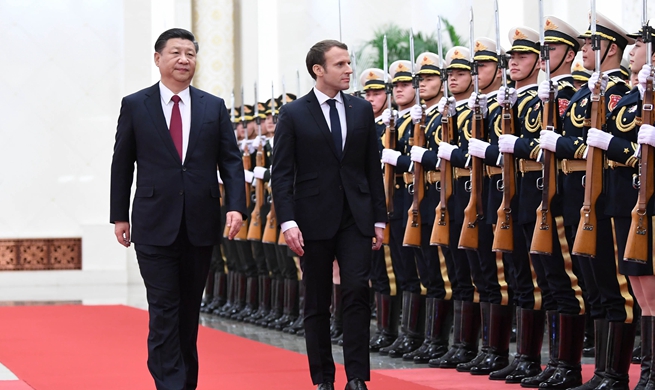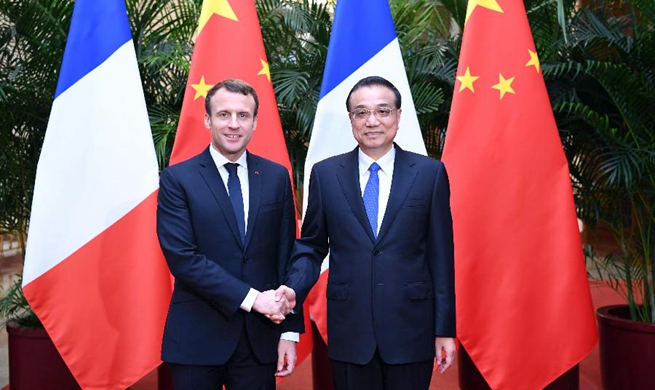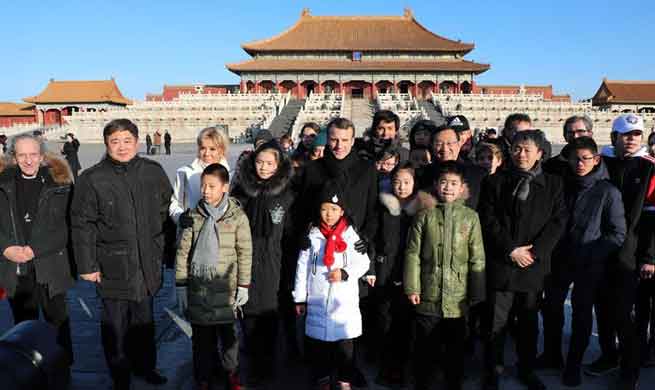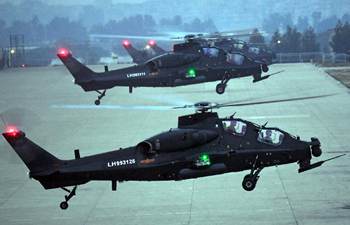by Xinhua writer Hu Tao
BEIJING, Jan. 10 (Xinhua) -- Airbus values China as its largest market and as a strategic partner in industrial cooperation, with more in-depth cooperation anticipated, a senior executive said.
"China is more and more important to Airbus. We have delivered more than 100 new Airbus aircraft for consecutive years," said Francois Mery, chief operating officer of Airbus Commercial Aircraft China.
Mery made the remarks while the French President Emmanuel Macron embarked on a three-day tour in China starting Monday.
HIGHER ANTICIPATION
"China has the ambition to develop its aviation in both the civil aviation and the manufacturing sector. To Airbus, it is win-win cooperation and development," Mery said.
Airbus on Tuesday signed a Memorandum of Understanding with the National Development and Reform Commission of China (NDRC) on further development of industrial cooperation in Tianjin.
Both sides agreed to further enhance their industrial cooperation by strengthening technical innovation, engineering capabilities and supply chain expansion.
On the same day, Airbus and its Chinese partners also signed a framework agreement on ramping-up its A320 production rate at its Final Assembly Line in Tianjin to six aircraft per month.
The target is five aircraft by early 2019 and six per month by early 2020. To date, the production rate in Tianjin is four per month.
"Airbus has set a target of realizing no less than 1 billion U.S dollars of investment in the industrial cooperation with China," Mery said.
In 2018, Airbus will deliver 10 A330 wide-body aircraft from its A330 Completion and Delivery Center (CDC) in north China's port city of Tianjin.
"More deliveries are also anticipated in 2019. And we expect it to become the next one following the Airbus Final Assembly Line Asia (FALA) as the best China--EU flagship program," Mery said.
The CDC was inaugurated on Sept. 20, 2017. It is the first center for its wide-body aircraft outside Europe.
China has received more than 100 new Airbus aircraft in consecutive years, accounting for 20 to 25 percent of Airbus annual global deliveries.
Airbus saw its industrial cooperation with China reach about 600 million U.S dollars in 2017. The volume in 2010 was 120 million U.S dollars.
VERTICAL INTEGRATION
"Airbus targets a vertical integration in cooperation with China, making more value-added parts in China and supporting more Chinese manufacturers joining our global supply chain," Mery said.
To Mery, vertical integration means that "we will not only sell planes, make parts or assemble aircraft here, but also make more made-in-China parts to fly on Airbus planes worldwide."
When Airbus first entered China in 1985, there was no private companies in the aerospace industry.
China has seen a surging aviation industry alongside its continuous reform and opening-up.
Besides the strengthening of the state-owned aviation giants such as the AVIC and COMAC, the country's burgeoning private aerospace and high-tech companies have also attracted the attention of the outside world.
"Forty years have past, the picture is changing," Mery said. " Both the state-owned giants and the private companies have gained tremendous growth."
Airbus has joined hands with its long-term big partner AVIC to extend the industrial cooperation from making parts and aircraft assembly to more value-added sectors such as cabin interiors.
More and more high-qualified private companies have joined the Airbus supplier list.
In late 2017, Xizi UHC, a private company based in Hangzhou in eastern China's Zhejiang Province, became an Airbus supplier of wing ribs for its single-aisle aircraft.
And Nanshan Group, a private manufacturing conglomerate in Shandong Province, is now under the process of qualification pre-screening as an Airbus supplier for aluminum extrusion raw materials. It is expected be approved in 2018.
"The Chinese government is pushing forward development of its private sector. More and more of them are competent in the global market, why not join hands with them?" Mery said. "We will also have a balance of cooperation with the state-owned AVIC and private companies. You should have different qualified partners; it is a good choice in business."
LATERCOMER'S EVOLUTION
The France-based European aviation giant have gained about half of the civil aviation market share in China. In 1996, it was just 9 percent.
"It is just part of the evolution of Airbus in China," Mery said.
In 1999, 14 years after first Airbus aircraft was delivered to China, it started industrial cooperation with AVIC in making parts for wings of the A320 family.
In 2008, a joint venture of the A320 final assembly line was set up in Tianjin to meet surging demand from Chinese clients. It is the third single-aisle aircraft final assembly line location of Airbus.
"It has become a flagship program of China-EU cooperation. And now, it is capable of delivering aircraft to customers in Asia-Pacific region," Mery said.
In 2017, Airbus reached multiple milestones in its industrial cooperation with China, such as its first aircraft delivery to an Asian customer from the final assembly line in Tianjin, the inauguration of the new A330 CDC and the setting-up of its second innovation center in Shenzhen.
"We are a latercomer of the global aviation industry, and we were lagging behind Boeing when we entered China, but win-win cooperation brings us here now," Mery said. "We have higher expectations and we are resolved to meet them." Enditem















